The interest in the success of the running game at Oregon has generated a number of comments about Duck Quarterback Anthony Brown our leading the blocking at times. Is this part of the offensive game-plan, or part of a particular play design? Before many of you become concerned about all the screenshots and a video–this article will take you less than five minutes to read, and you will learn a little Oregon football in the process. (And there is only one play in the video)
Offensive Coordinator Joe Moorhead was asked this question a week ago in this interview (the video starts where he is answering the question) and he explained..
“Not only is it (getting out to block) encouraged from the position, (QBs) it is expected. Anytime the ball is handed off and we are not reading a second or third level defender–we (our QBs) are sprinting five yards past the line-of-scrimmage full speed, either to pull people away from the play, or to get out in front.
I tell quarterbacks the same thing we tell receivers; our job is to turn short runs into long runs, and long runs into touchdowns. Obviously we need to be smart in how we’re doing it.”
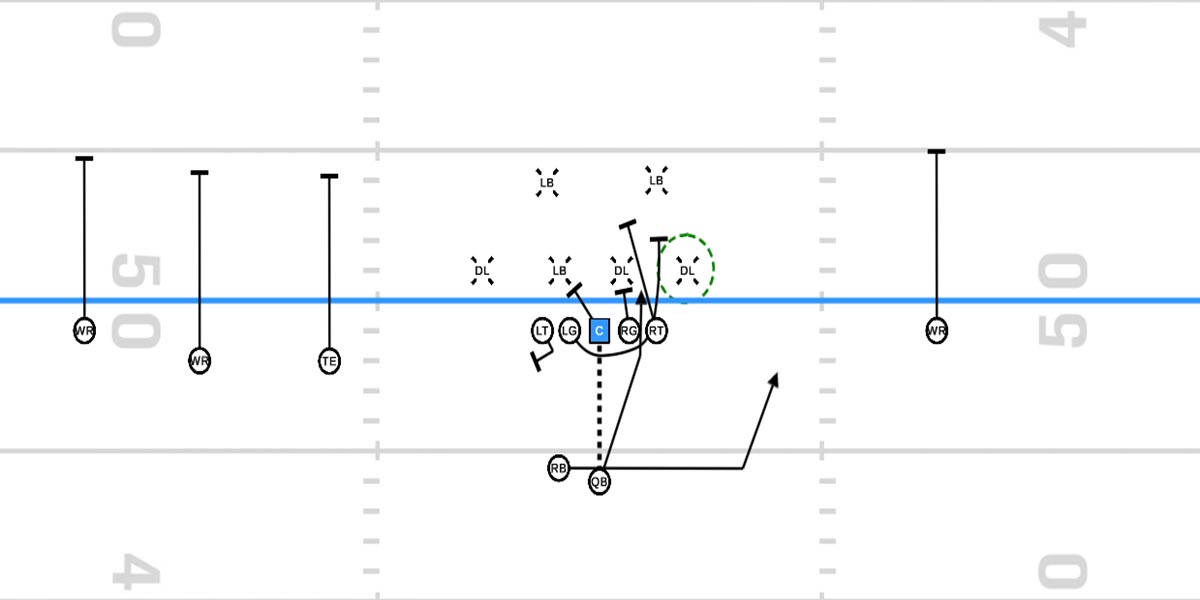
Classic Inverted Veer/Power Read
I have been delighted with adjustments made within the offense, and the offensive line as moving TJ Bass to tackle (for example) was a great move because he blocks so well out in space against agile defenders. Moving George Moore inside to offensive guard utilized his ability to blast defenders to the inside, as I saw a number of devastating blocks by the super-senior where his earth-moving strength created wonderful holes for our running backs.
The play against Washington and the Cougars where Anthony Brown lead the blocking was the Inverted Veer, that Coach Boles has covered in our Analysis Library. (No, Rod Gilmore, it was not a counter) It is a play (diagram from Coach Boles above) where the quarterback reads a defender and based upon his decision will then hand off to the running back or keep it and run off tackle in an open gap. Let’s take a look at Oregon’s version under Joe Moorhead…
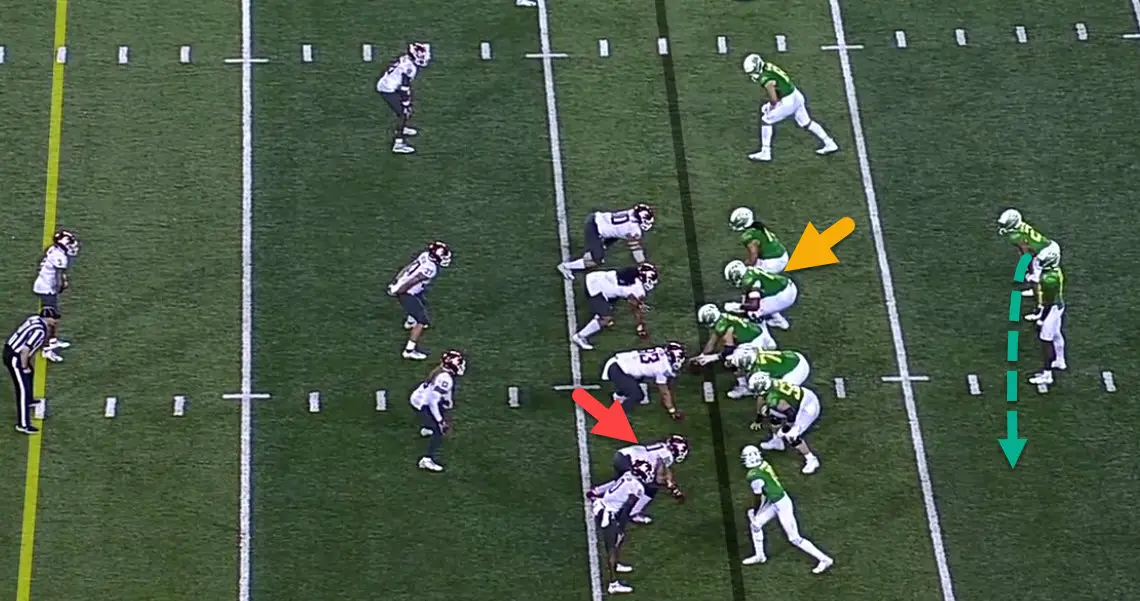
Washington State has seven in the box with a safety within easy run-support help.
How do five on the Oregon offensive line block seven Cougars in the box and create a touchdown? It starts with noting that Byron Cardwell (running back No. 21 and green dotted line above) will be running across the front of Anthony Brown and they will do the mesh while Brown is “reading” the defender marked by the red arrow above. Know in advance the big Steven Jones, No. 74 and yellow arrow above is going to pull to lead the blocking to Oregon’s left side.
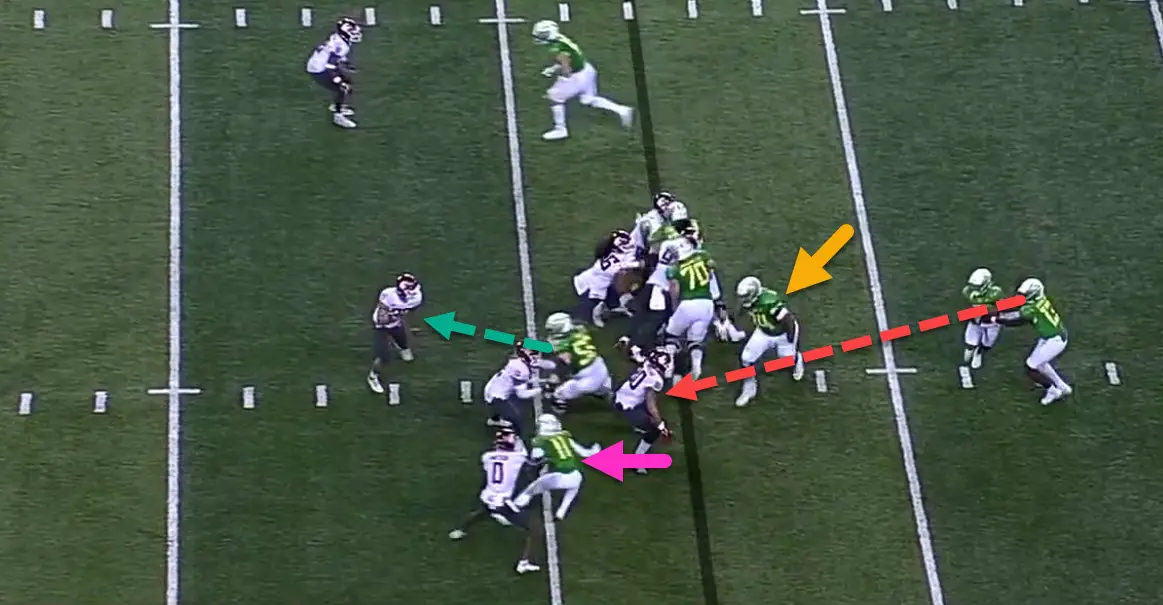
This play is off to a great start, but could get “fowled” up with a Franklin slip.
First of all, look at No. 70, the left guard Dawson Jamarillo, who just caves-in the defensive tackle and create one side of an emerging hole. Note how Brown is looking (dotted red line) right at the “read” defender and since the Cougar is “sitting” and plugging a gap that the QB would run through, the correct action is to hand-off to Cardwell as Brown is doing.
While it may appear that Jones (yellow arrow above) is headed for the “read” defender, he actually will not block him. That is how you start to even up the blocking odds; observe how TJ Bass (green dotted line above) has picked out his blocking target. The freshman Troy Franklin, No. 11, (pink arrow above) is looking right at the linebacker he is to block, but as he is moving towards him–he slips and is going down.
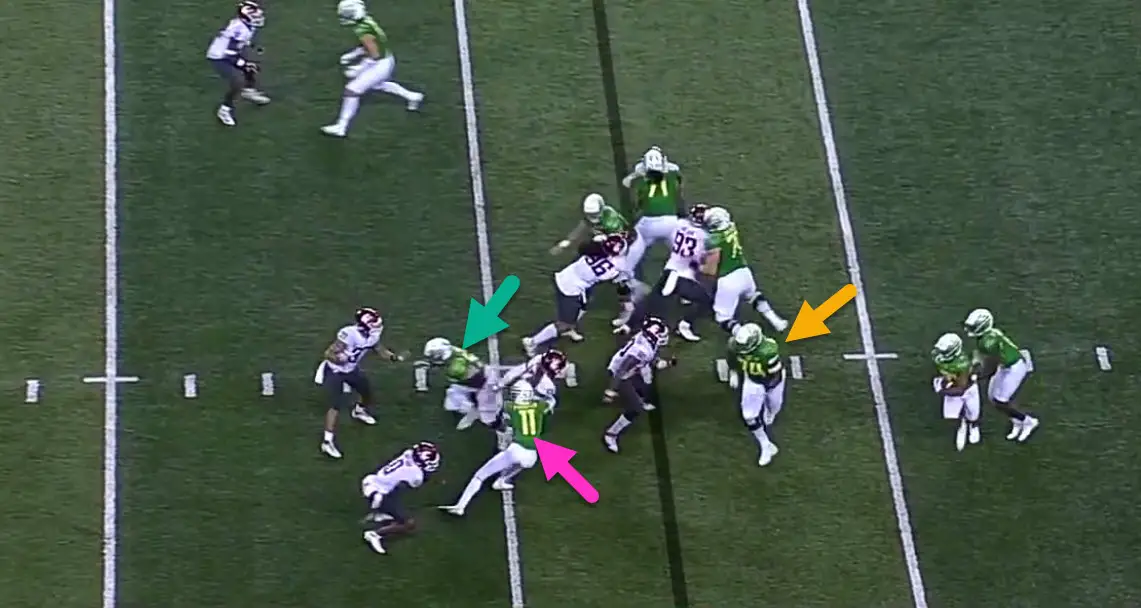
Is this play going to blow-up or get blown up?
We see TJ Bass (green arrow above) closing in on his linebacker, and sure enough Steven Jones (yellow arrow above) is running past the “read” defender because that Cougar will be out of the play. The pink arrow is pointing to Troy Franklin, who knows that if he going to hit the turf–fall into the defender he is supposed to block and effectively “shield” him away from the play and thus help create the running lane.
——————————————————————————————–
The Our Beloved Ducks Forum is BACK! Come get the links to Oregon Sports articles, the press releases from the Oregon Athletic Department and the news from your fellow Duck fans. It is the only safe place on the web for Duck Discussion, such as today’s article, so join us over there!
——————————————————————————————–
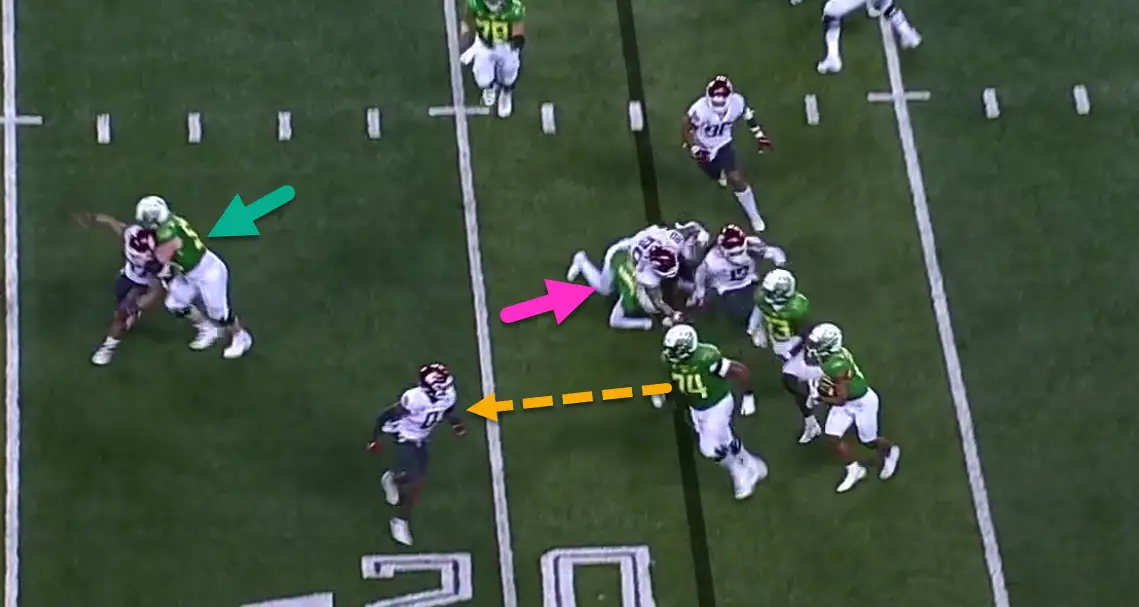
Now the blocking numbers have reversed in this play!
Now the excitement begins! Nothing big happens downfield unless a block is made to stop the backside linebacker, and TJ Bass (green arrow above) is making a great open-field block on his defender. Steven Jones (dotted yellow line above) is taking aim on his hapless defender, but the drama in the play is the pink arrow above, Troy Franklin. When he fell, he not only shielded his assigned defender, but a backside defender then tripped over Franklin, and thus Troy got a twofer!
The path now looks great as No. 13, Anthony Brown is a blocker looking for a defender, and Caldwell will let him lead the way.
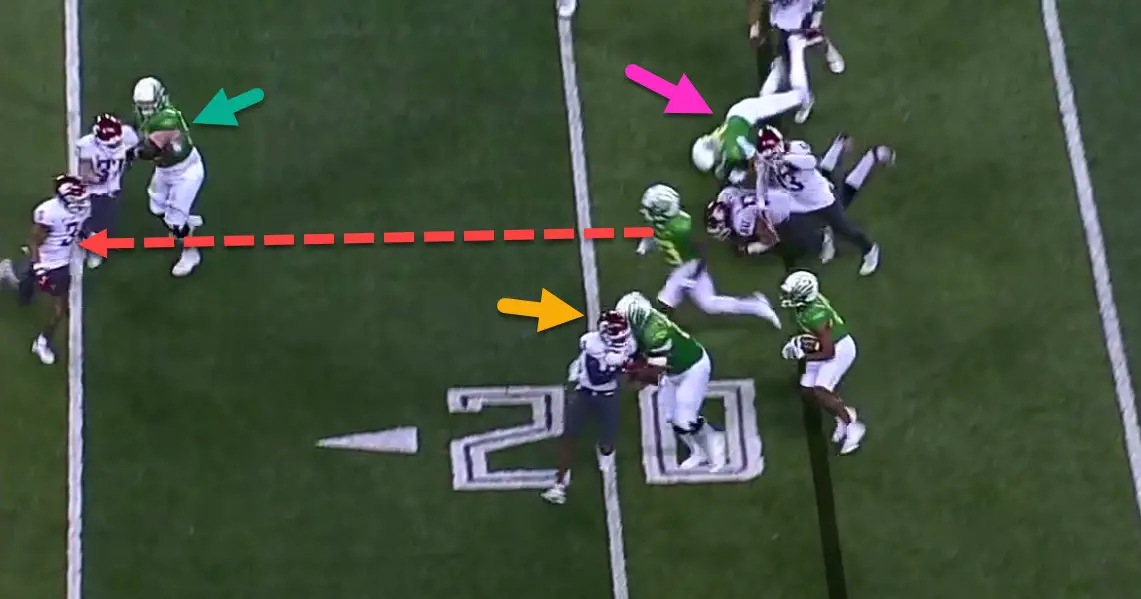
Now the extra blocker in Brown is going to come handy…
Bass (green arrow above) is still in command of his block, as is Jones (yellow arrow above) and if Brown (red dotted line above) can block No. 3, the safety for Washington State–then Byron Caldwell can cut back inside their blocks. Troy Franklin, (pink arrow above) fell down, but he took two defenders out and finishes with an important role in the success of this play.
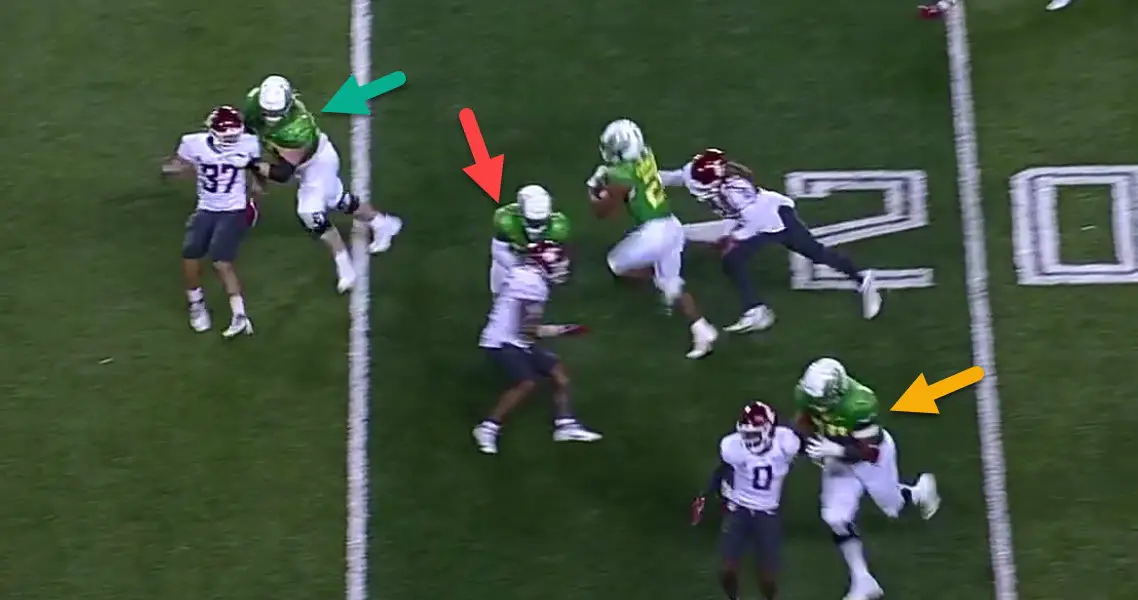
Now we’re off to the races…
Jones (yellow arrow above) closed his defender off to the outside, Bass (green arrow above) has closed off his defender as well and Anthony Brown (red arrow above) is blocking from the side that creates an easy running lane for Caldwell. In the touchdown up at Montlake, Jaylon Redd took on a big linebacker by launching into him. The result was a stalemate, but it shielded the Husky as the Dye-Guy zipped past. Receivers and quarterbacks are making big blocks for big plays!
Now let’s check out the play below in slow-motion and look for what we learned in the above screenshots.
In the end–the extra blocker (the quarterback) was able to complete the hat-on-hat downfield blocking, and what started as a disadvantage in blocking numbers ended up even. Reading a defender instead of blocking him, and the addition of Brown downfield equalized the numbers and from there the superb blocking skills of the Ducks offensive line, receivers and quarterback created a touchdown!
“Oh, how we love to ponder about Our Beloved Ducks!”
Charles Fischer (Mr. FishDuck)
Eugene, Oregon
Top Photo from ESPN Video
Come join us in the new Our Beloved Ducks Forum, where you get the news about Oregon Sports and is the safest place on the web to read and post your opinions!

Charles Fischer has been an intense fan of the Ducks, a season ticket holder at Autzen Stadium for 38 years and has written reports on football boards for over 26 years. Known as “FishDuck” on those boards, he is acknowledged for providing intense detail in his scrimmage reports, and in his Xs and Os play analyses. He is single, has a daughter Christine, and resides in Eugene Oregon where he was a Financial Advisor for 36 years.
He now focuses full-time on Charitable Planned Giving Workshops for churches and non-profit organizations in addition to managing his two Oregon Football Websites, of FishDuck.com and the Our Beloved Ducks forum. He is a busy man!
He does not profess to be a coach or analyst, but simply a “hack” that enjoys sharing what he has learned and invites others to correct or add to this body of Oregon Football! See More…
